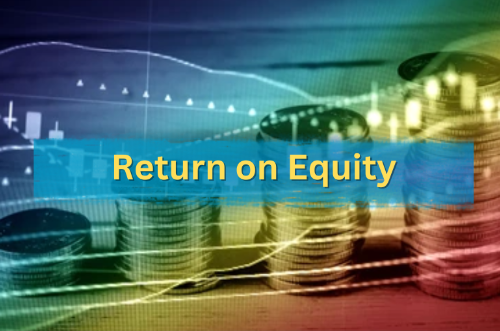The Power of Return on Equity in Financial Analysis

Understanding Return on Equity (ROE)
The financial world is driven by analysis. This involves delving into the numbers, ratios, and formulas that show the financial health and future potential of a business. A key player in this financial analysis arena is Return on Equity (ROE).
Commonly referred to as a ‘profitability ratio,’ return on equity is a measure that provides insights into how effectively a company’s management uses shareholders’ equity to generate profits. However, as with all things in finance, understanding ROE or the power of it is hardly a simplistic task.
Calculating Return on Equity
Return on equity (ROE) measures a company’s profitability by revealing how much profit a company generates with the money shareholders have invested. Calculated as Net Income divided by Shareholder’s Equity, ROE is expressed as a percentage.
For instance, if a company’s net income is INR 10lakh, and the shareholder’s equity is INR 40lakh, the ROE would be 25%. This means that for every rupee of equity invested, the company generates 25 paise in profit.
Comparing ROE and ROCE
Often seen alongside ROE, is another key analytical term – return on capital employed (ROCE). While both these figures form part of a financial analyst’s toolkit, they serve slightly different purposes. While ROE solely speaks about the returns on the equity shareholders’ investment, ROCE provides a broader picture by considering the company’s total capital, i.e., both equity and debt. It’s calculated as Earnings Before Interest and Tax (EBIT) divided by (Total Assets – Current Liabilities). In essence, ROCE shows how well a company is generating returns from its total available capital.
Importance of ROE and ROCE for Investors
Both return on equity and return on capital employed play significant roles in assisting investors to understand the efficiency with which a company’s management is using its capital and equity. By applying these metrics, investors can compare the profitability of companies in relation to the money that has been invested into the business. The higher the ROE and ROCE, the better the company is perceived in utilizing its equity and capital. However, these ratios should ideally not be looked at in isolation. A holistic approach, encompassing ratio analysis, growth prospects, and market conditions, will yield a clearer picture.
Contextual Understanding of ROE and ROCE
Investing is not just about numbers. It’s about understanding these numbers in context. ROE and ROCE can vary widely depending on the industry and the size of the company. It’s essential to compare these ratios only among companies from the same sector. And while these metrics are essential, they are not the be-all and end-all. A high ROCE doesn’t necessarily indicate that a company is a good investment opportunity. Factors such as company management, governance, and growth prospects play an equally important role.
A common caveat while analyzing ROE is not to fall for unusually high values. A very high ROE often signals high financial leverage, meaning the company has a significant amount of debt compared to its equity. High debt can lead to unsustainable ROEs. Moreover, while a positive ROE indicates a potentially profitable company, it should not be mistaken for actual profit.
Conclusion
In the quest for successful investing, Return on Equity is a useful ally. As an analytical tool, it provides pertinent insights into a company’s profitability and the effectiveness with which it uses its equity. However, understanding its limitations and nuances is equally important. The investor must gauge all the pros and cons, examine other ratios, consider market conditions, and perform a comprehensive analysis before trading in the Indian stock market.
Bajaj Finserv App offers a seamless way to manage your financial needs on the go. With this app, you can easily apply for loans, check your EMI status, and pay bills. It also provides access to pre-approved offers, investment options, and insurance services. The user-friendly interface ensures quick navigation, while robust security features protect your data. Whether you’re managing credit cards or tracking investments, Bajaj Finserv App simplifies financial management right from your smartphone.
Summary
Return on Equity (ROE) is a key metric in financial analysis, providing insights into how effectively a company utilizes shareholders’ equity to generate profits. Calculated as Net Income divided by Shareholder’s Equity, ROE is expressed as a percentage. For example, if a company has a net income of INR 10 lakh and shareholders’ equity of INR 40 lakh, the ROE would be 25%. This indicates that the company generates 25 paise in profit for every rupee of equity invested.
ROE is often compared with Return on Capital Employed (ROCE), which measures returns on both equity and debt. ROCE is calculated as EBIT divided by (Total Assets – Current Liabilities). While both metrics are valuable for assessing a company’s efficiency, they should be analyzed in the context of the industry and not in isolation. High ROE values might indicate high financial leverage, which could be risky.
Disclaimer:
This article is for informational purposes only and is not intended to be investment advice. Investing in the Indian stock market involves risk, and investors are recommended to do proper research and/or consult a professional advisor before making any investment decisions.










